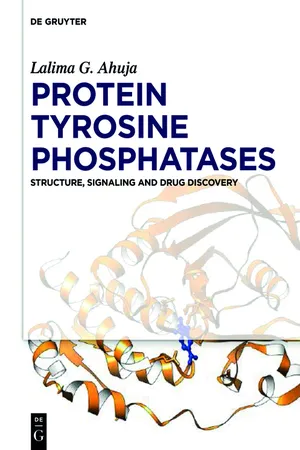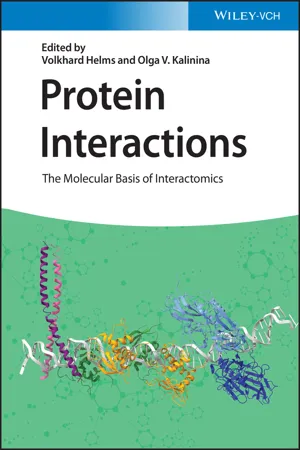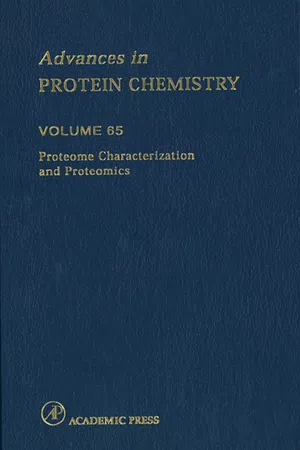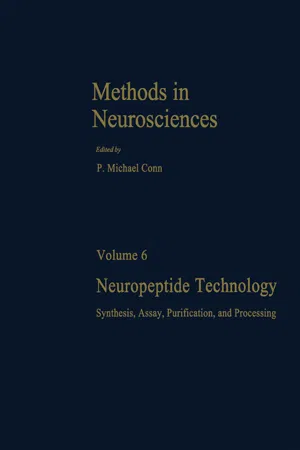Biological Sciences
Protein Phosphorylation
Protein phosphorylation is a common post-translational modification in which a phosphate group is added to a protein molecule. This process is crucial for regulating various cellular functions, including cell signaling, metabolism, and gene expression. Protein phosphorylation is often carried out by enzymes called kinases and can lead to changes in protein structure, activity, and interactions with other molecules.
Written by Perlego with AI-assistance
Related key terms
Related key terms
1 of 4
Related key terms
1 of 3
12 Key excerpts on "Protein Phosphorylation"
- eBook - ePub
Protein Tyrosine Phosphatases
Structure, Signaling and Drug Discovery
- Lalima G. Ahuja(Author)
- 2018(Publication Date)
- De Gruyter(Publisher)
1 Tyrosine phosphorylation in cell signaling: Discovery and beyond1.1 Protein Phosphorylation
Protein Phosphorylation serves as the currency of cellular signaling and allows for protein functional regulation and spatial control. It is shown to be a key biological process in both prokaryotes and eukaryotes [1 ,2 ,3 ,4 ], and forms the basis of signaling pathways as we understand today. Protein Phosphorylation is a covalent modification wherein a phosphate (PO4 3− ) group is chemically attached to certain residues in target proteins. The negative charge of the phosphate allows for an alteration in the conformation of the said protein, thus allowing for a modulation of its function. The protein’s conformation change depends on its structural context and directly affects its activation/in-activation, protein–protein interaction with other cognate partners and also its own recycling in the cell. Many cellular receptors, adaptors, enzymes, transcription factors, DNA-binding modules and also cytoskeletal proteins are regulated for their spatiotemporal responses using a simple phosphorylation–dephosphorylation switch. As much 30% of all proteins in cells are speculated to be phosphorylated at any given time [5 ], and alterations in these phosphorylation states of these proteins are being increasingly linked to diseases and pathophysiology [6 ].Protein Phosphorylation predominantly occurs on the serine (Ser), threonine (Thr) and tyrosine (Tyr) amino acid side chains of proteins that form acid-stable phosphomonoesters using their hydroxyl side chains (Figure 1.1 ). Histidine (His), arginine (Arg) and lysine (Lys) residues use their basic side chains to form acid-labile phosphoramidates. Acidic residues, namely, aspartate (Asp) and glutamate (Glu) make acyl-phosphates. Cysteine (Cys) residues are phosphorylated on their sulfhydryl side chains to form thiophosphates. Multisite Protein Phosphorylation on serine/threonine and tyrosine residues is a key feature of many eukaryotic signaling processes [7 ]. Histidine and aspartate phosphorylations are a hallmark of the two-component system and multicomponent signaling systems that connect extracellular stimuli of osmolarity and nutrients to gene regulation in both bacteria and plants [8 , 9 ]. Histidine phosphorylation is known to be crucial in mammalian gene regulation with specific relevance in cardiovascular physiology and heart diseases [10 , 11 ]. Phosphoproteome analysis of the mammalian heart mitochondria has identified histidine and cysteine phosphorylations on pyruvate dehydrogenase and sarcomeric mitochondrial creatine kinase [12 ]. Histidine and cysteine phosphorylation are also shown to be important for the regulation of phosphoenolpyruvate-dependent carbohydrate transport system in prokaryotes [13 ]. As the phosphoramidates of arginine and lysine are difficult to detect, their significance is presently understudied. These nitrogen phosphorylations have been detected in histone proteins [14 - eBook - ePub
Systems Biomedicine
Concepts and Perspectives
- Edison T. Liu, Douglas A. Lauffenburger(Authors)
- 2009(Publication Date)
- Academic Press(Publisher)
Part II. Protein Phosphorylation Networks
Phosphoproteins are of tremendous importance in eukaryotic cellular signaling and regulation. Protein kinases—proteins that catalyze the phosphorylation of other proteins—are the third most common family of proteins in the human genome, with 518 members ( Manning et al., 2002 ). It has been estimated that 30% of human proteins are substrates for these kinases ( Cohen, 2002 ), with resulting effects in nearly every aspect of biology. Protein kinases catalyze the transfer of a phosphate moiety from a molecule of ATP to a protein. Although other residues can be phosphorylated, the vast majority of stable Protein Phosphorylations in eukaryotes occur on the hydroxyl moiety of serine, threonine and tyrosine amino acid side chains. An analysis of several eukaryotic genomes suggested that 75% of eukaryotic kinases phosphorylate serine and threonine residues, while the remaining 25% are tyrosine-specific ( Rubin et al., 2000 ).Phosphorylation of proteins by protein kinases is regulated at several levels. First, the kinase and potential ligand must be co-localized in the cell. Secondly, the kinase activity is generally increased when the kinase is in an active structural conformation. The catalytic domains of most protein kinases share a similar active state conformation, but are often activated by a conformational change from a less similar inactive state, driven by a variety of mechanisms ( Huse and Kuriyan, 2002 ). These mechanisms include phosphorylation of the kinase itself on a flexible “activation” loop ( Johnson and Lewis, 2001 ), inter- or intramolecular allostery ( Gonfloni et al., 2000 ) and release of an intramolecular substrate-competitive inhibitor sequence ( Lei et al., 2000 ). It has been noted ( Huse and Kuriyan, 2002 ) that the diversity among kinase domain inactive state conformations lends itself to the design of kinase inhibitors that function specifically by stabilization of the kinase-specific inactive states, as the anticancer drug, imatinib mesylate (Gleevec), does in the case of the Abl kinase ( Zimmermann et al., 1997 ), rather than less specifically by obstructing the ATP binding site, which is relatively well conserved among kinases. Finally, kinase activity on a substrate is also influenced by recognition of the substrate amino acid sequence surrounding the phosphate receptor side chain ( Kennelly and Krebs, 1991 - eBook - ePub
- Timothy D. Veenstra, John R. Yates, Timothy D. Veenstra, John R. Yates(Authors)
- 2019(Publication Date)
- Wiley-Blackwell(Publisher)
11 PhosphorylationTimothy D. VeenstraDepartment of Applied Science, Maranatha Baptist University, Watertown, WI, USA11.1 INTRODUCTION
While DNA is considered the “blueprint” of the cell or organism, it is proteins that carry out the innumerable biological functions necessary to sustain life. While the primary structure, consisting of the sequence of amino acids that make up the protein, plays a major role in how the protein folds and functions, additional covalent modifications are often required to regulate such dynamic activities as cell division, metabolism, recognition, biomolecular interactions, and cell structure. These modifications, collectively known as posttranslational modification s (PTM s), are much more diverse than the amino acids that make up the proteins themselves. While their importance has been recognized for some time, the sheer number and types of PTMs have only recently been uncovered, primarily owing to the use of mass spectrometry (MS ) to conduct high‐throughput sequencing of proteins. There are several hundred types of PTMs that can modify the side chains of amino acids or affect the protein backbone itself. Unlike its primary sequence, the PTMs that occur to a protein can be highly dynamic and are continually altered during its lifetime. This dynamic feature alters the protein's function in response to stimuli or the current state of the cell or organism.Of all the known PTMs, phosphorylation is currently considered the most important to the life of the cell. If importance correlates with sheer number, then phosphorylation is by far the most critical PTM. In 2011, a group published the number of specific types of PTMs that were reported in SwissProt, a curated protein database considered to contain high‐quality data (Khoury et al. 2001 ). All of these PTMs were reported as being found experimentally. As shown in the top graph of Figure 11.1 , phosphorylation was by far the most commonly identified PTM. As far as the specific residues that are modified are concerned, phosphoserine (pSer ) was overwhelmingly the most commonly identified type of modified residue (bottom graph Figure 11.1 ). This residue was followed by phosphothreonine (pThr ), while phosphotyrosine (pTyr ) was ranked sixth overall. A logical result of the sheer number and importance of phosphorylated residues is the number of databases that have been developed to catalog these sites (Table 11.1 - eBook - ePub
Protein Interactions
The Molecular Basis of Interactomics
- Volkhard Helms, Olga V. Kalinina(Authors)
- 2022(Publication Date)
- Wiley-VCH(Publisher)
17 Phosphorylation‐Based Molecular SwitchesAttila ReményiInstitute of Organic Chemistry, Biomolecular Interactions Research Group, Research Center for Natural Sciences, H‐1117 Budapest, Hungary17.1 Introduction
There are several posttranslational modifications (), such as phosphorylation, ubiquitination, acetylation, methylation, glycosylation, lipidation, and proteolysis. These chemical modifications on proteins have the ability to regulate activity, affect interactions with other molecules, or influence cellular localization and thus local concentration. PTMs happen fast compared to gene expression level‐based mechanisms involving transcriptional regulation. They may be reversible or irreversible and could be categorized based on the chemical nature of the group attached to amino acid side chains: peptide adducts (ubiquitination and sumoylation), small chemical groups (acetylation, methylation, phosphorylation), more complex molecules (glycosylation, isoprenylation), or protein cleavage by proteolysis.Protein Phosphorylation is probably the most widespread posttranslational regulatory mechanism. Modification of amino acids (e.g. aspartate, histidine, but most prominently serine/threonine or tyrosine) by kinases plays a key role in signal transduction or in controlling gene expression. Why is phosphorylation so widespread and effective? First, Protein Phosphorylation requires the transfer of the γ‐phosphoryl group from ATP to an amino acid side chain, and since ATP is abundant and is constantly restocked, the source is readily at hand. Second, the phosphate group on proteins is highly loaded: it has two negative charges that could have large effects on the chemical nature of the phosphorylated protein region [1 ].Phosphorylation of the alkyl/aryl hydroxyl group of a serine, threonine, or tyrosine residue results in the formation of an ester bond, which is chemically stable under neutral pH. Phosphorylation on six more amino acids is also chemically feasible: on cysteine by forming a phosphorothiolate bond, on aspartate or glutamate forming a mixed anhydride, or on histidine, arginine or lysine forming a phosphoramidate. However, these latter are chemically more labile in aqueous solution under physiological conditions and are not as widely used as alkyl/aryl hydroxy amino acids. Histidine and aspartate phosphorylation in so‐called two‐component systems elicits a quick response to extracellular signals since the half‐life of histidine phosphoramidate is short and the mixed anhydride bond of phospho‐aspartate also spontaneously hydrolyzes. This ancient signaling system, comprising a membrane‐bound histidine kinase and the cytoplasmic response regulator modified on aspartate by the former, is frequently used in bacteria, but it is less frequent in eukaryotes, albeit it is present in yeast and is quite common in plants [2 - eBook - ePub
- Wendell Lim, Bruce Mayer, Tony Pawson(Authors)
- 2014(Publication Date)
- Garland Science(Publisher)
Chapter 3 , we discussed some of the properties of the phosphate group that make it particularly useful for signaling: in short, phosphorylation allows the cell to use a readily available raw material (ATP) to induce stable and significant alterations in protein structure and function. Although the phosphoester linkage is relatively stable to spontaneous hydrolysis, in the cell its reactions can be rapidly catalyzed through the opposing actions of protein phosphatases and protein kinases.The importance of phosphorylation in regulating signaling pathways is suggested by the increasing importance of kinase inhibitors in the treatment of human disease. Since all protein kinases use ATP as a substrate of the phosphoryl transfer reaction, ATP analogs (small molecules that mimic ATP, but cannot be used for phosphate transfer) are useful as protein kinase inhibitors. Many of these compounds are now used clinically as drugs, for example, to inhibit kinases that cause cancer.Phosphorylation is often coupled with protein interactions
In addition to its direct effects on protein structure, phosphorylation has another important role in signaling: it can dramatically affect the interaction of a protein with other proteins in the cell. As already noted, both serine/threonine and tyrosine phosphorylation lie at the heart of writer/eraser/reader systems, in which proteins containing modular phosphorylation-specific binding domains “read” changes in phosphorylation by binding specifically to certain proteins only after they are phosphorylated.This type of system was first appreciated in signaling by receptors with tyrosine kinase activity. When cells were stimulated with ligands for such receptors, in many cases the most abundantly phosphorylated substrate was found to be the receptor itself. This rather puzzling observation raised the question of how the signal was transmitted, in the absence of significant phosphorylation of downstream substrates. The discovery of a modular domain that binds specifically to peptides in the tyrosine- phosphorylated state (the SH2 domain) provided a solution to the puzzle: autophosphorylation of the receptor led to the recruitment of SH2- containing proteins from the cytosol to the receptor on the membrane. This change in localization brought SH2-containing enzymes into close proximity with their substrates on the membrane, thereby increasing their activity (Figure 4.11a - eBook - ePub
Cellular Signal Processing
An Introduction to the Molecular Mechanisms of Signal Transduction
- Friedrich Marks, Ursula Klingmüller, Karin Müller-Decker(Authors)
- 2017(Publication Date)
- Garland Science(Publisher)
MAP kinase modules are components of numerous signaling pathways connecting almost every receptor type with the metabolic machinery and the genome. The evolutionary success of the module is probably due to the fact that such a device works as a highly efficient noise filter, delivering an extremely sharp signal as a prerequisite for frequency modulation. Indeed, MAP kinase modules are integrated in positive and negative feedback loops in such a way that the conditions for generation of oscillating signals are fulfilled, though experimental proof is still lacking. A frequency-modulated code could easily explain why, depending on the conditions, a single MAP kinase module may exert contrary effects: for example, stimulation of cell proliferation and survival upon short-term activation versus an antimitotic effect or even induction of cell death upon long-term activation. Possibly the survival signal simply has another frequency than the death signal.Summary• Phosphorylation ranks among the most ancient and most abundant post-translational modifications of proteins. It is catalyzed by protein kinases that use ATP (or in a few cases GTP or phosphoenolpyruvate) as a phosphate donor. Protein phosphatases render the modification reversible.• In addition to some minor families of atypical protein kinases, two unrelated superfamilies of protein kinases are known: His autokinases (predominantly found in prokaryotes) and kinases phosphorylating Ser, Thr, and Tyr residues.• Protein kinases are signal-operated switching elements. In the absence of input signals, most protein kinases are blocked by auto-inhibition. Many kinases require, in addition, phosphorylation of the activation loop (a structure in the catalytic center) to become active.• Frequently several protein kinases are combined into multiprotein modules; the eukaryotic MAP kinase module being the most prominent example.• Phosphorylation has three major effects on proteins: electrostatic repulsion of negatively charged partner molecules, conformational changes resulting in altered activity, and generation of contact sites for interacting proteins.• Like kinases, protein phosphatases are also signal-operated switching elements. Ser/Thr-specific phosphatases exist in a few catalytic domains that noncovalently couple with a large number of regulatory subunits. In Tyr-specific phosphatases, the regulatory and catalytic domains share the same polypeptide chain. - eBook - ePub
- I. Y. Rosenblum(Author)
- 2021(Publication Date)
- CRC Press(Publisher)
Figure 1 .FIGURE 1. Receptor-mediated mechanisms of transmembrane signaling.The importance of phosphorylation reactions in cell regulation was recognized first in the 1950s when the mechanism of catecholamine-induced liver glycogenolysis was elucidated. The discovery of cyclic AMP (cAMP) as the second messenger in this transmembrane signaling cascade paved the way for our current understanding of how information may be communicated intra- and intercellularly. The actions of a large number of hormones appear to be mediated via cAMP by means of kinase-catalyzed phosphorylation of protein substrates that underlie the cascade of reactions responsible for signal transduction. Among the numerous cellular trafficking systems demonstrated to be regulated by phosphorylation-dephosphorylation reactions, the cAMP-initiated cascades are the most thoroughly characterized to date. The mechanisms responsible for the ubiquitous and pleiotropic nature of cAMP as a regulatory molecule have been reviewed recently.2Phosphorylation can be defined as the covalent modification of target substrates by phosphate transfer. The process is catalyzed by various kinases and phosphatases and has been recognized as a central mechanism by which a variety of external stimuli regulate cellular functions. Phosphorylation modulates the enzymatic activity of target proteins and has been shown to be a mediator of hormonal transduction in cells of both normal and diseased tissues.A wealth of information exists to suggest that phosphorylation of target proteins is an intermediate step in the physiological actions of various growth hormones and growth factors. Until a decade ago, hormone-induced Protein Phosphorylation was documented to occur only on serine and threonine residues. In 1979, another class of protein kinases was discovered which specifically phosphorylated tyrosine residues in target proteins.3 The critical role of specific amino acid residue phosphorylation was firmly established following the demonstration that several growth factor receptors, including epidermal growth factor (EGF), platelet derived growth factor (PDGF), insulin-like growth factor I (IGF-I), and insulin, exhibit intrinsic tyrosine kinase activity.4 , 5 , 6 , 7 , 8 , 9The enzyme activities of these receptors appear to be regulated by both autophosphorylation and phosphorylation catalyzed by other kinases. For example, the EGF receptor is believed to be phosphorylated on threonine residues by protein kinase C.10 The observation that phorbol esters, potent stimulants of protein kinase C, are able to induce increased phosphorylation of the EGF receptor in A431 cells supports this hypothesis.11 The possibility that Protein Phosphorylation on tyrosine residues may be important in the regulation of cell proliferation has been supported by the recent finding that cells transformed by acutely oncogenic retroviruses have elevated levels of phosphotyrosine. It is known now that at least seven retroviral oncogenes possess tyrosine-specific protein kinase activity.12 In addition, the receptors for EGF, PDGF, and insulin have amino acid sequences highly homologous to oncogene products.13 ,14These data suggest that phosphorylation is a critical component of the process of signal transduction required for the expression of a number of biological effects. The role of phosphorylation of cell surface receptors in the regulation of signal transduction pathways has been reviewed recently.15 - eBook - ePub
- Timothy D. Veenstra, Richard D. Smith(Authors)
- 2003(Publication Date)
- Academic Press(Publisher)
Cellular processes including cell cycle progression, differentiation, development, peptide hormone response, and adaptation are all regulated by Protein Phosphorylation. Often regulation of protein function by phosphorylation occurs without a change in the abundance of the protein. Classic methods used to study Protein Phosphorylation primarily employ protein radiolabeling with 32 P-labeled inorganic phosphate (32 P i). The radioactive proteins are used in fractionation procedures such as two-dimensional polyacrylamide gel electrophoresis (2D-PAGE) or high-performance liquid chromatography (HPLC). To determine the amino acid types that are modified, the phosphoproteins is completely hydrolyzed and the phosphoamino acid content determined. The specific site(s) of phosphorylation can be determined by proteolytic digestion of the radiolabeled protein, separation and detection of phosphorylated peptides (e.g., by two-dimensional peptide mapping), followed by Edman sequencing. To measure differences in relative abundances of phosphorylation, 32 P-labeled proteomes are separated by 2D-PAGE and the relative spot intensities are compared [ 8 ]. The use of 32 P i to label proteins does not lend itself to high-throughput proteome-wide analysis because of issues with handling radioactive compounds and the associated contamination of analytical instrumentation. Fortunately, MS-based methods have been developed that provide more effective methods to identify, and potentially quantify, specific sites of phosphorylation. In its simplest form, MS can be used to provide an accurate mass measurement of an intact phosphorylated protein. Comparing this mass with the calculated mass of the unmodified protein or the mass of the protein after phosphatase treatment allows the number of bound phosphate groups to be calculated [ 9 ] - eBook - ePub
Neuropeptide Technology
Synthesis, Assay, Purification, and Processing
- P. Michael Conn, P. Michael Conn(Authors)
- 2013(Publication Date)
- Academic Press(Publisher)
Many neurotransmitters and neurohormones initiate biochemical changes in postsynaptic cells that modulate important neuronal functions. These modulatory influences allow neurons to maintain homeostasis, to adapt to injury or altered external conditions, and to store information about prior events. A common pathway through which a great many neuronal functions are regulated is Protein Phosphorylation. Knowledge about the nature, location, and timing of functionally significant Protein Phosphorylation events is important for understanding adaptive neuronal responses and for dissecting the complexity of molecular mechanisms underlying learning and memory.Unfortunately, Protein Phosphorylation is not easy to study in situ . Protein Phosphorylation systems are “ noisy. ” Functionally important phosphorylation sites can usually be stoichiometrically phosphorylated at a high rate by the appropriate protein kinase. However, many proteins are also phosphorylated at sites that have little functional significance. Often phosphorylation at these sites is slow and incomplete. The presence of this second class of sites makes quantitative study of the time course and functional significance of phosphorylation and dephosphorylation difficult. Most phosphorylated proteins must be broken into small peptides in order to measure the extent of phosphorylation of particular sites.In this chapter, we first describe methods that have been used in our laboratory to identify and sequence functionally important sites of phosphorylation within the brain enzyme, type II Ca2+ /calmodulin-dependent protein kinase (type II CaM kinase), an enzyme composed of multiple copies of two major catalytic α and β subunits in varying proportions. Then we describe methods that we have used to prepare antibodies that recognize the CaM kinase only when it is phosphorylated at one of these sites. Such antibodies can be used for sensitive and specific assay of phosphorylation of their cognate site, and possibly for immunocytochemical visualization of the location of the phosphorylation event in situ - Thomas Russell(Author)
- 2012(Publication Date)
- Academic Press(Publisher)
4 ), and it seems likely that Protein Phosphorylation is the major general mechanism by which metabolic events in eukaryotic cells are controlled by external physiological stimuli.In the first part of this article, recent progress in understanding the regulation of glycogen metabolism in skeletal muscle by phosphorylation-dephosphorylation will be summarized. In the second part, evidence will be presented that several of the proteins in glycogen metabolism are also involved in the regulation of other metabolic processes. These findings have raised the exciting possibility that there are a relatively simple network of regulatory pathways which allow the activities of diverse but functionally related cellular processes to be controlled in a synchronous manner.II IDENTIFICATION OF CALMODULIN AS A SUBUNIT OF MUSCLE PHOSPHORYLASE KINASE
Phosphorylase kinase is the enzyme at which the neural and hormonal mechanisms for stimulating glycogenolysis meet in a single protein, since its activity is dependent on calcium ions and is stimulated by cyclic AMP dependent protein kinase (reviewed in 5). Several years ago we reported that phosphorylase kinase possessed the structure (αβγ)4 where the molecular weights of the α,β and γ-subunits were 145,000, 128,000 and 45,000 respectively (6 ). The α and β-subunits were found to be the components phosphorylated by cyclic AMP dependent protein kinase (6 –10 ) and this raised the question of which subunit(s) bound the calcium ions, that were essential for activity.Recently, phosphorylase kinase has been shown to contain a fourth component, termed the δ-subunit (11 ). This subunit has a molecular weight of 17,000, and is in equimolar concentration with the other subunits. Phosphorylase kinase therefore has the structure (αβγδ)4- eBook - ePub
Biochemical Targets of Plant Bioactive Compounds
A Pharmacological Reference Guide to Sites of Action and Biological Effects
- Gideon Polya(Author)
- 2003(Publication Date)
- CRC Press(Publisher)
8 Signal-regulated protein kinases
8.1 Introduction
A major signalling mechanism in eukaryotes involves “primary messengers” (such as hormones, neur otransmitters and other extracellular signals) interacting with specific plasma membrane (PM) receptors with a resultant transient increase in the cytosolic concentration of so-called “second messenger” substances such as 3 ´,5 ´-cyclic AMP (cAMP), guanosine 3 ´,5 ´-cyclic monophosphate (cGMP), inositol-1,4,5- triphosphate (IP3), diacylgylcerol (DAG) and Ca2+ (Chapters 5 and 7). The “second messengers” ultimately act by activating protein kinases (PKs) that catalyse the phosphorylation of specific target proteins:Protein-OH +ATPlprotein-O-PO3 +ADP +H2 OProtein Phosphorylation alters protein ligand binding and/or catalytic functions and hence specific cellular processes, this representing the cellular “response” to the “stimulus” of the original “primary messenger”. The signalling system must be reversible and the Protein Phosphorylation step of the “stimulus–response” pathway is reversed through the action of phosphoprotein phosphatases (PPs), w hich are phosphohydrolases that catalyse the hydrolytic dephosphorylation of proteins:Of the approximately 35,000 genes in the human genome, it has been estimated that about 1000 encode PKs and that several hundred encode PPs. These enzymes have a regulatory function (a useful analogy would be that of law officers in society) and often have overlapping functions or are otherwise backed up. (Thus, the absence of particular law officers might make society more disorderly but does not cause total anarchy.) For example, a “gene knockout” mouse lacking a regulatory subunit for the cAMP-activated PK (PKA) survives to breed but does not become obese on a diet of plenty. Lack of obesity arises because PKA is activated in the absence of the inhibitory regulatory subunit, the enzyme triglyceride lipase (TGL) is consequently mostly in the phosphorylated and activated form and triglycerides are rapidly broken down and catabolized. A mouse lacking phosphorylase b kinase (PhosbK) (a key PK involved in regulating glycogen breakdown and catabolism) survives to breed but as a “wee timorous beastie” that shivers uncontrollably. - eBook - ePub
- Sudhir Kumar(Author)
- 2013(Publication Date)
- Pergamon(Publisher)
There is valuable information to be gained from studies in which behavioral effects on in vivo phosphorylation are studied, as well as from studies of effects on in vitro phosphorylation. At present, knowledge of the basic biochemistry of Protein Phosphorylation and dephosphorylation is so limited that the in vivo and in vitro approaches complement one another. Although the in vivo approaches cast a wider net, the in vitro studies lend themselves more readily to biochemical analysis. Either approach is full of behavioral pitfalls for the unwary, and it sometimes seems that an almost limitless number of behavioral control experiments is required to definitely establish the true behavioral correlates of a given biochemical phenomenon. Scientists who are interested in going in to research on behavioral effects on phosphorylation of brain proteins, however, should not be discouraged by the complexities and difficulties (if not sheer impossibility) of behavioral analysis at the present time or in the foreseeable future. Everything we learn, including our mistakes, will be useful in guiding the development of better means of attaining insight into how the brain carries out its functions. ACKNOWLEDGEMENT The author is grateful to his colleagues Robert F. Berman, John P. Hullihan and William J. Kinnier for their helpful suggestions and criticisms during the preparation of this chapter in the spring of 1977. REFERENCES AgranofF, B.W. Actinomycin-D blocks formation of memory of shock-avoidance in goldfish. Science. 1968; 158:1600–1601. Allfrey, V.G. Changes in chromosomal proteins at times of gene activation. Fedn. Proc. Fedn. Am. Socs. exp. Biol. 1970; 29:1447–1460. Anchors, J.M., Karnovsky, M.L. Purification of cerebral glucose-6-phosphatase an enzyme involved in sleep. J. Biol. Chem. 1975; 250:6408–6416. Antoniw, J.F., Nimmo, H.G., Yeaman, S.Y., Cohen, P
Index pages curate the most relevant extracts from our library of academic textbooks. They’ve been created using an in-house natural language model (NLM), each adding context and meaning to key research topics.
Explore more topic indexes
Explore more topic indexes
1 of 6
Explore more topic indexes
1 of 4











